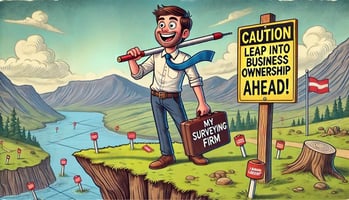Introduction No one will argue that there’s a stark contrast between business owner and employee....
When I Tried to Do It All (and Nearly Lost My Coffee and Mind)
Introduction
Every now and then, I get one of those wild ideas that today’s the day I’m finally going to “catch up.” You know the type—you wake up feeling unstoppable, like a caffeinated superhero with a to-do list.
So there I was, bright and early, ready to conquer the day. Emails? I’d answer them all. Invoices? Knock ’em out. Scheduling? Done before breakfast. Client calls? Bring ’em on.
By 10:00 a.m., I had three half-finished tasks, two half-empty coffee cups, and a full-blown migraine.
Turns out, trying to do everything yourself isn’t efficient—it’s just chaos with better stationery.

Morning Ambition Meets Reality
Running a land surveying business means wearing more hats than a Kentucky Derby. Some days I’m a project manager. Other days, I’m the IT guy, the bookkeeper, and the therapist for whoever just got their boots stuck in the mud.
That particular morning, I was all of them at once. I started by fixing a scheduling conflict (“No, you can’t be in two counties at 9 a.m.”), then jumped into drafting review (“Wait, why is there a tree growing out of the setback line?”). Midway through an email about a quote revision, I got a call from a crew chief who lost his data collector charger.
By lunch, I’d eaten three pretzels, sent one half-written invoice, and forgotten why I walked into my own office.
The Multitasking Myth
For years, I thought the key to success was doing more—faster. If I wasn’t juggling three tasks at once, I felt like I was slacking. I called it “efficiency.” My wife called it “nonsense.”
And she was right. (She usually is.)
When you’re constantly jumping between jobs, you’re not managing your business—your business is managing you. Every interruption knocks something else loose. You might think you’re saving time, but you’re actually just spreading mistakes evenly across your entire operation.
In surveying terms: multitasking is like trying to run a traverse while juggling your rods—you might finish, but you won’t trust the results.
The Turnaround
That’s when I learned the power of letting systems—and people—do their jobs.
I started leaning on better project management and scheduling tools to handle the busywork I used to try and keep in my head. Scheduling, invoicing, project updates—all there, all connected. I could see what was happening without personally babysitting it.
And suddenly, I wasn’t the bottleneck anymore. The crews had clarity. The office had consistency. And I actually got to finish a cup of coffee while it was still warm—which, for a business owner, is the true measure of success.
Reflection
Owning a business isn’t about doing everything yourself. It’s about building systems that keep everything moving, even when you’re not the one pushing. Whether you’re managing survey crews, drafting plans, or trying to find that one missing field note, you’ve got to let the tools and the team carry part of the load.
Because when you stop micromanaging and start trusting your process, you get something rare: breathing room.
Conclusion
That day I tried to do it all—I didn’t fail because I wasn’t working hard enough. I failed because I was working on everything instead of the right things.
Now, I focus on what really needs me—the decision-making, the relationships, the things no software can drink coffee and laugh about. The right tools help with the rest.
Editor’s Note: Gus uses Kudurru Stone to manage scheduling, projects, and communication across his surveying teams.
If your to-do list needs its own project manager, it’s time to let the software do the heavy lifting.




